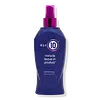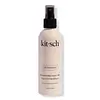What's inside
What's inside
 Key Ingredients
Key Ingredients

No key ingredients
 Benefits
Benefits

 Concerns
Concerns

 Ingredients Side-by-side
Ingredients Side-by-side

Water
Skin ConditioningPropylene Glycol
HumectantCetearyl Alcohol
EmollientCyclopentasiloxane
EmollientBehentrimonium Chloride
PreservativePanthenol
Skin ConditioningSilk Amino Acids
HumectantAloe Barbadensis Leaf Juice
Skin ConditioningCamellia Sinensis Leaf Extract
AntimicrobialHelianthus Annuus Seed Extract
Skin ConditioningQuaternium-80
Butylene Glycol
HumectantPhenoxyethanol
PreservativeMethylparaben
PreservativePropylparaben
PreservativeEthylparaben
PreservativeParfum
MaskingCitronellol
PerfumingHexyl Cinnamal
PerfumingLimonene
PerfumingLinalool
PerfumingWater, Propylene Glycol, Cetearyl Alcohol, Cyclopentasiloxane, Behentrimonium Chloride, Panthenol, Silk Amino Acids, Aloe Barbadensis Leaf Juice, Camellia Sinensis Leaf Extract, Helianthus Annuus Seed Extract, Quaternium-80, Butylene Glycol, Phenoxyethanol, Methylparaben, Propylparaben, Ethylparaben, Parfum, Citronellol, Hexyl Cinnamal, Limonene, Linalool
Water
Skin ConditioningCetearyl Alcohol
EmollientGlycerin
HumectantButylene Glycol
HumectantParfum
MaskingHydrogenated Ethylhexyl Olivate
EmollientPhenoxyethanol
PreservativeAstrocaryum Murumuru Seed Butter
EmollientBehentrimonium Chloride
PreservativeHydroxypropyl Starch Phosphate
Ethylhexylglycerin
Skin ConditioningPanthenol
Skin ConditioningHelianthus Annuus Extract
EmollientSclerocarya Birrea Seed Oil
HumectantHydrogenated Olive Oil Unsaponifiables
EmollientTetradecane
PerfumingSaccharide Isomerate
HumectantArgania Spinosa Kernel Oil
EmollientRaphanus Sativus Seed Extract
Skin ConditioningOctyldodecyl Oleate
EmollientOctyldodecanol
EmollientSodium PCA
HumectantSodium Lactate
BufferingLysolecithin
EmulsifyingPolysorbate 20
EmulsifyingXanthan Gum
EmulsifyingArginine
MaskingAspartic Acid
MaskingPotassium Sorbate
PreservativeSodium Benzoate
MaskingPCA
HumectantMagnolia Officinalis Bark Extract
AntimicrobialGlycine
BufferingAlanine
MaskingSerine
MaskingValine
MaskingCitric Acid
BufferingSodium Citrate
BufferingIsoleucine
Skin ConditioningProline
Skin ConditioningThreonine
Rosmarinus Officinalis Leaf Extract
AntimicrobialPhenylalanine
MaskingHistidine
HumectantAlpha-Isomethyl Ionone
PerfumingHydroxycitronellal
PerfumingTetramethyl Acetyloctahydronaphthalenes
MaskingWater, Cetearyl Alcohol, Glycerin, Butylene Glycol, Parfum, Hydrogenated Ethylhexyl Olivate, Phenoxyethanol, Astrocaryum Murumuru Seed Butter, Behentrimonium Chloride, Hydroxypropyl Starch Phosphate, Ethylhexylglycerin, Panthenol, Helianthus Annuus Extract, Sclerocarya Birrea Seed Oil, Hydrogenated Olive Oil Unsaponifiables, Tetradecane, Saccharide Isomerate, Argania Spinosa Kernel Oil, Raphanus Sativus Seed Extract, Octyldodecyl Oleate, Octyldodecanol, Sodium PCA, Sodium Lactate, Lysolecithin, Polysorbate 20, Xanthan Gum, Arginine, Aspartic Acid, Potassium Sorbate, Sodium Benzoate, PCA, Magnolia Officinalis Bark Extract, Glycine, Alanine, Serine, Valine, Citric Acid, Sodium Citrate, Isoleucine, Proline, Threonine, Rosmarinus Officinalis Leaf Extract, Phenylalanine, Histidine, Alpha-Isomethyl Ionone, Hydroxycitronellal, Tetramethyl Acetyloctahydronaphthalenes
 Reviews
Reviews

Ingredients Explained
These ingredients are found in both products.
Ingredients higher up in an ingredient list are typically present in a larger amount.
This ingredient is a preservative and often used for it's anti-static properties. You'll most likely see this ingredient in hair conditioners.
It does not cause irritation or sensitization in leave-on products at 1-5%.
Butylene Glycol (or BG) is used within cosmetic products for a few different reasons:
Overall, Butylene Glycol is a safe and well-rounded ingredient that works well with other ingredients.
Though this ingredient works well with most skin types, some people with sensitive skin may experience a reaction such as allergic rashes, closed comedones, or itchiness.
Learn more about Butylene GlycolCetearyl alcohol is a mixture of two fatty alcohols: cetyl alcohol and stearyl alcohol. It is mainly used as an emulsifier. Emulsifiers help prevent the separation of oils and products. Due to its composition, it can also be used to thicken a product or help create foam.
Cetearyl alcohol is an emollient. Emollients help soothe and hydrate the skin by trapping moisture.
Studies show Cetearyl alcohol is non-toxic and non-irritating. The FDA allows products labeled "alcohol-free" to have fatty alcohols.
This ingredient is usually derived from plant oils such as palm, vegetable, or coconut oils. There is debate on whether this ingredient will cause acne.
Due to the fatty acid base, this ingredient may not be Malassezia folliculitis safe.
Learn more about Cetearyl AlcoholPanthenol is a common ingredient that helps hydrate and soothe the skin. It is found naturally in our skin and hair.
There are two forms of panthenol: D and L.
D-panthenol is also known as dexpanthenol. Most cosmetics use dexpanthenol or a mixture of D and L-panthenol.
Panthenol is famous due to its ability to go deeper into the skin's layers. Using this ingredient has numerous pros (and no cons):
Like hyaluronic acid, panthenol is a humectant. Humectants are able to bind and hold large amounts of water to keep skin hydrated.
This ingredient works well for wound healing. It works by increasing tissue in the wound and helps close open wounds.
Once oxidized, panthenol converts to pantothenic acid. Panthothenic acid is found in all living cells.
This ingredient is also referred to as pro-vitamin B5.
Learn more about PanthenolParfum is a catch-all term for an ingredient or more that is used to give a scent to products.
Also called "fragrance", this ingredient can be a blend of hundreds of chemicals or plant oils. This means every product with "fragrance" or "parfum" in the ingredients list is a different mixture.
For instance, Habanolide is a proprietary trade name for a specific aroma chemical. When used as a fragrance ingredient in cosmetics, most aroma chemicals fall under the broad labeling category of “FRAGRANCE” or “PARFUM” according to EU and US regulations.
The term 'parfum' or 'fragrance' is not regulated in many countries. In many cases, it is up to the brand to define this term.
For instance, many brands choose to label themselves as "fragrance-free" because they are not using synthetic fragrances. However, their products may still contain ingredients such as essential oils that are considered a fragrance by INCI standards.
One example is Calendula flower extract. Calendula is an essential oil that still imparts a scent or 'fragrance'.
Depending on the blend, the ingredients in the mixture can cause allergies and sensitivities on the skin. Some ingredients that are known EU allergens include linalool and citronellol.
Parfum can also be used to mask or cover an unpleasant scent.
The bottom line is: not all fragrances/parfum/ingredients are created equally. If you are worried about fragrances, we recommend taking a closer look at an ingredient. And of course, we always recommend speaking with a professional.
Learn more about ParfumPhenoxyethanol is a preservative that has germicide, antimicrobial, and aromatic properties. Studies show that phenoxyethanol can prevent microbial growth. By itself, it has a scent that is similar to that of a rose.
It's often used in formulations along with Caprylyl Glycol to preserve the shelf life of products.
Water. It's the most common cosmetic ingredient of all. You'll usually see it at the top of ingredient lists, meaning that it makes up the largest part of the product.
So why is it so popular? Water most often acts as a solvent - this means that it helps dissolve other ingredients into the formulation.
You'll also recognize water as that liquid we all need to stay alive. If you see this, drink a glass of water. Stay hydrated!
Learn more about Water